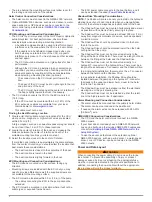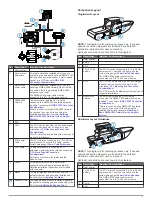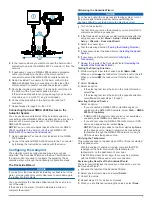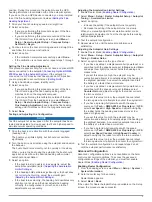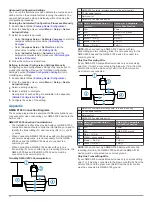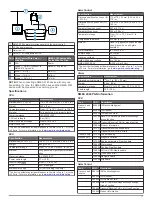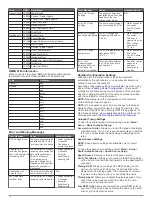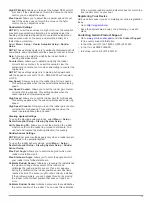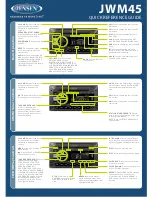
position. During this procedure, the autopilot uses the GPS
heading information to calibrate north on the autopilot system.
If you do not have a GPS device connected, you are prompted
to set the fine heading adjustment instead (
).
1
Drive your boat at cruising speed in a straight line.
2
Select an option:
• If you are performing this procedure as part of the Sea
Trial Wizard, select
Begin
.
• If you are performing this procedure outside of the Sea
Trial Wizard, from the heading screen, select
Menu
>
Setup
>
Dealer Autopilot Setup
>
Compass Setup
>
Set North
>
Begin
.
3
Continue to drive the boat at cruising speed in a straight line
and follow the on-screen instructions.
4
Select an option:
• If the calibration completes successfully, select
Done
.
• If the calibration is not successful, repeat steps 1 through
3.
Setting the Fine Heading Adjustment
This procedure appears only if you do not have an optional GPS
device connected to the autopilot (
2000 Devices to the Autopilot System
). If the autopilot is
connected to a GPS device that has acquired a GPS position,
you are prompted to set north instead (
).
1
Using a handheld compass, identify north.
2
Select an option:
• If you are performing this procedure as part of the Sea
Trial Wizard, adjust the fine heading setting until it
matches north on the magnetic compass.
• If you are performing this calibration outside of the Sea
Trial Wizard, from the heading screen, select
Menu
>
Setup
>
Dealer Autopilot Setup
>
Compass Setup
>
Fine Heading Adjustment
, and adjust the fine heading
setting until it matches north on the magnetic compass.
3
Select
Done
.
Testing and Adjusting the Configuration
NOTICE
Test the autopilot at a slow speed. After the autopilot has been
tested and adjusted at a slow speed, test it at a higher speed to
simulate normal operating conditions.
1
Drive the boat in one direction with the autopilot engaged
(heading hold).
The boat may oscillate slightly, but it should not oscillate
significantly.
2
Turn the boat in one direction using the autopilot and observe
the behavior.
The boat should turn smoothly, not too quickly or too slowly.
When you turn the boat using the autopilot, the boat should
approach and settle on the desired heading with minimal
overshoot and oscillation.
3
Select an option:
• If the boat turns too quickly or too sluggishly, adjust the
autopilot acceleration limiter (
).
• If the heading hold oscillates significantly or the boat does
not correct when turning, adjust the autopilot gain
(
Adjusting the Autopilot Gain Settings
• If the boat turns smoothly, the heading hold oscillates only
slightly or not at all, and the boat adjusts the heading
correctly, the configuration is correct, and no further
adjustments are necessary.
Adjusting the Acceleration Limiter Settings
1
Enable Dealer Mode (
2
Select
Menu
>
Setup
>
Dealer Autopilot Setup
>
Autopilot
Tuning
>
Acceleration Limiter
.
3
Select an option:
• Increase the setting if the autopilot turns too quickly.
• Decrease the setting if the autopilot turns too slowly.
When you manually adjust the acceleration limiter, make
relatively small adjustments. Test the change before making
additional adjustments.
4
Test the autopilot configuration.
5
Repeat steps 3–4 until the autopilot performance is
satisfactory.
Adjusting the Autopilot Gain Settings
1
Enable Dealer Mode (
).
2
Select
Menu
>
Setup
>
Dealer Autopilot Setup
>
Autopilot
Tuning
>
Rudder Gains
.
3
Select an option based on the type of boat:
• If you have a sailboat, a displacement-hull powerboat, or a
powerboat with the speed source set to
None
, select
Gain
and adjust how tightly the rudder holds the heading and
makes turns.
If you set this value too high, the autopilot may be
overactive and attempt to constantly adjust the heading at
the slightest deviation. An overactive autopilot can drain
the battery at a faster-than-normal rate.
• If you have a sailboat, a displacement-hull powerboat, or a
powerboat with the speed source set to
None
, select
Counter Gain
and adjust how tightly the rudder corrects
the turn overshoot.
If you set this value too low, the autopilot can overshoot
the turn again when it attempts to counter the original turn.
• If you have a planing-hull powerboat with the speed
source set to
Tach. - NMEA 2000 or Proprietary
or
GPS
,
select
Low Speed
or
High Speed
and adjust how tightly
the rudder holds the heading and makes turns at low
speed or high speed.
If you set this value too high, the autopilot may be
overactive and attempt to constantly adjust the heading at
the slightest deviation. An overactive autopilot can drain
the battery at a faster-than-normal rate.
• If you have a planing-hull powerboat with the speed
source set to
Tach. - NMEA 2000 or Proprietary
or
GPS
,
select
Low Speed Counter
or
High Speed Counter
to
adjust how tightly the rudder corrects the turn overshoot.
If you set this value too low, the autopilot can overshoot
the turn again when it attempts to counter the original turn.
4
Test the autopilot configuration, and repeat steps 2 and 3
until the autopilot performance is satisfactory.
Advanced Configuration
Advanced configuration options are not available on the helm
control under normal conditions. To access the advanced
configuration settings of the autopilot, you must first enable
Dealer Mode (
).
Enabling Dealer Configuration
1
From the heading screen, select
Menu
>
Setup
>
System
>
System Information
.
2
Hold the center key for 5 seconds.
Dealer Mode appears.
3
Select
Back
>
Back
.
If the option for Dealer Autopilot Setup is available on the Setup
screen, the procedure was successful.
9


